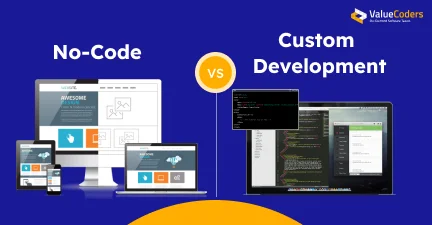Java is one of the most popular programming languages used today since its inception in the programming world.
The uses of this programming language go beyond the messengers. Programming with Java is ubiquitous for web banking and fintech applications. Java stands out in terms of functionality and security environment compared to other programming languages. According to W3Techs, Java is used by less than 0.1% of all websites and many popular websites such as Udemy.com, Gcalc.net, Dukascopy.com, etc.
According to Oracle, it is the most used runtime platform for many enterprise systems including 97% of desktops. Moreover, more than 3 billion devices run Java in some form. Many web development companies use Java for some of their functions, and Java server applications process tens of millions of requests daily.
In this blog, we will discuss how Java is good for web app development and how much it is beneficial for businesses these days.
A Java web application has become an obvious business need in recent years. This is because the new versions of Java are continuously enhancing the possibilities in the web app development. With the increased demand for web app development, businesses are looking to hire Java developers.
1) Scalability
Java programming language is easily scalable for web app development. It is because the components are widely available. If you plan to scale your web application horizontally or vertically, the language will adapt to your needs, especially in commercial logic and permanent storage levels.
In simple words, it means that each time you decide to improve your web application’s response time and performance, less invasive coding will be required and Java developers will invoice fewer hours.
2) Cross-platform
Java’s secret sauce lies in its Java Virtual Machine (JVM), which acts as a universal translator between your code and the machine it’s running on. This means your carefully crafted code doesn’t need to be rewritten for each specific platform. It’s like having a multilingual interpreter that ensures your message is conveyed accurately, regardless of the listener’s native tongue.
Platform independence is a truly remarkable aspect of Java in the realm of web application development. Imagine crafting a piece of code on your local machine, infused with your creative energy, and then watching it effortlessly come to life on various devices and operating systems. It’s like conducting a symphony that harmonizes across a diverse orchestra of platforms.
Also Read – What’s All Is There In The Store Of WordPress 5.5- Let’s Take A Sneak Peak
3) Memory Management
This may be a bit technical, but there is a simple way to understand how easily Java handles memory. That’s why it is discussed in brief below:
In Java programming, all Java objects “live” it is called a “heap”. A heap is created when a web application starts and can increase or might decrease as it is executed. If the pile is filled, then the “garbage” is collected and eliminated.
Basically, objects that are no longer used are deleted. New objects have space to enter. There are other aspects of this, such as the “nursery” where the newer objects are stored and the “previous space” where the oldest objects of the children’s room go before they are finally eliminated.
The point here is saying that an automatic system to manage the memory is there. Thus, in turn, this helps in managing the effectiveness and speed of the web application.
Also Read – Top 15 Best Databases for Web Applications To Use In 2025
4) Multi-threading
Java web applications can manage their own use by several users at the same time. This can be done by creating threads for each user within the program itself instead of having to execute multiple copies of the programming on the same hardware. In this process, each thread is tracked until the “job” ends.
Below, there are some advantages of multi-threading:
– Fewer glitches: Multi-threaded servers will always remain responsive and will work no matter how long a particular process runs, while single-threaded servers may stop responding and “block” their operations.
– Fast response time: User commands are processed in a matter of seconds, even when the application is used by a large number of people simultaneously.
– Multiple operations: A number of operations can be executed simultaneously and your web app does not think long before making this step.
– Better performance: The app’s performance would be better due to the optimal usage of cache storage and CPU resources. Your web app will remain stable and be glitching-free.
– Low maintenance cost: This is due to various economic resources usage.
5) Budget-friendly
Java is a budget-friendly language which is universally popular. However, finding a reliable Java development company for a budget-proof project can be difficult for many business owners. This is in fact quite challenging when you want to develop your web app with a budget-friendly language like Java. Moreover, hiring a Java development company must be within the parameters of the client’s budget constraints.
Empower your web development application with our expertise.
Best Practices For Java Web Application Development
Building a web application with Java can be a rewarding journey, but it’s essential to follow best practices to ensure your project’s success.
This section will dive into some key guidelines to help you create robust and maintainable Java web applications.
1. Code Organization and Modularization
Organizing your code makes everything easier to find and manage. In Java web development, it’s crucial to structure your code into manageable modules or packages. Here’s how to do it:
- Package Naming: Use meaningful package names that reflect the purpose of the classes within them. For instance, you can have packages for controllers, models, services, and utilities.
- Separation of Concerns: Follow the principle of separation of concerns. Keep business logic, presentation, and data access in separate layers to make your code more maintainable and less error-prone.
- Use of Design Patterns: Apply design patterns like MVC (Model-View-Controller) or DAO (Data Access Object) to organize your code effectively.
2. Testing and Quality Assurance
Quality assurance is ensuring your application runs smoothly and doesn’t break unexpectedly. Here’s what you should do:
- Unit Testing: Write unit tests for your code to verify that individual components work as expected. Popular testing frameworks like JUnit can help you with this.
- Integration Testing: Test how different parts of your application interact with each other. Ensure that your application’s modules work together seamlessly.
- Continuous Integration (CI): Set up a CI/CD pipeline to automate testing and deployment. Tools like Jenkins or Travis CI can be handy for this purpose.
- Code Reviews: Collaborate with your team to review each other’s code. Code reviews help identify issues and improve code quality.
Also read:Importance Of Java For Software Development & Its Applications
3. Security Best Practices
Security helps prevent unauthorized access. In web development, security should be a top priority:
- Authentication and Authorization: Implement secure authentication and authorization mechanisms. Use frameworks like Spring Security to manage user access.
- Data Validation: Validate and sanitize user inputs to prevent SQL injection, XSS (Cross-Site Scripting), and other security vulnerabilities.
- Session Management: Manage user sessions securely to protect sensitive user data.
- Regular Updates: Keep your application and dependencies up to date to patch known security vulnerabilities.
Also Read: What Is Java Used For? 9 Things You Can Create
4. Continuous Integration and Deployment (CI/CD)
CI/CD automatically assembles and delivers your product. It streamlines the development and deployment process:
- Automated Builds: Use build tools like Maven or Gradle to automate the build process. This ensures consistency and reduces human error.
- Continuous Deployment: Automate the deployment process to reduce downtime and make it easier to release updates.
- Version Control: Use a version control system like Git to manage your codebase. This helps track changes, collaborate with team members, and roll back to previous versions if needed.
5. Documentation
Documentation is like the user manual for your application. It helps developers understand how your code works and how to use it:
- Code Comments: Add meaningful comments to your code to explain complex or non-intuitive sections.
- API Documentation: If your application provides APIs, document them thoroughly, including endpoints, request/response formats, and authentication requirements.
- User Guides: Create user-friendly guides or documentation for end-users to understand how to use your application.
Also read: Top 7 Java Web Development Companies To Secure Enterprise-Grade Solutions
6. Performance Optimization
Performance optimization is A fast application that enhances user experience and can reduce server costs:
- Database Optimization: Efficiently structure your database queries. Use indexing, caching, and connection pooling to improve database performance.
- Caching: Implement caching mechanisms to reduce the load on your server and improve response times.
- Load Testing: Test your application under heavy loads to identify performance bottlenecks and optimize accordingly.
- Profiling: Use profiling tools to identify performance bottlenecks in your code and optimize them.
7. Error Handling and Logging
Here’s how error handling and logging can help your Java web application:
- Graceful Error Handling: Handle errors gracefully to provide meaningful error messages to users and log detailed error information for debugging.
- Logging: Implement logging to record important events and errors in your application. Use logging frameworks like Log4j or SLF4J.
Remember, these best practices are not set in stone. Depending on your project’s size and complexity, you may need to adapt and customize them. T
The key is prioritizing code quality, security, and maintainability to ensure your Java web application serves its purpose effectively and stands the test of time.
Elevate your web applications using Java's power.
Conclusion:
Java has been termed as the “king of programming”. This the obvious reason what makes Java a suitable choice for web app development. It is so versatile and offers robust custom web solutions for almost all type of commercial needs. This “top position” shows no signs of decline, especially now that Java 9 is on the horizon. Every time it gets better.
However, many other technologies have emerged around us, JAVA is still staying strong and has tons of followers. If you are a startup and planning for a web app development, Java can be your good choice to start with.
Hire Java developers from ValueCoders and opt for Software product development services. We have built hundreds of digital products with Java and provide fast development to Startups and SMEs.





